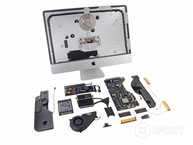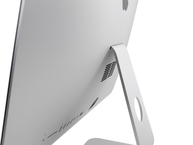FSW: Apple iMac Computer
Friction Stir Welding Joins the Front and Back Case Parts of the Apple iMac Computer
The front and back case parts of the 2012 version of the 21.5" Apple iMac are made from aluminium and joined together in large-scale production by friction stir welding
At the end of 2012, Apple revealed that the front and rear parts of the very slim aluminium case of the Apple iMac Intel 21.5" EMC 2544 would be joined together in high-volume production by friction stir welding.[1]
Apple has successfully saved many hundredths of millimetres in the design and manufacture, so that the housing appears significantly thinner than that of the predecessor model.
However, the desktop computer, which has been available since the end of 2012, is now much more difficult to disassemble than the predecessor model. With the necessary experience, it is still possible to replace the RAM, the hard disk and the CPU if necessary, although these parts are difficult to access. For this, the glue of the fragile screen has to be removed with a hot air blower to get to the inner workings.
Previously, iMacs had user-accessible RAM bays on the bottom, making it easy to upgrade. The RAM is still not soldered to the motherboard, contrary to that of the latest Retina MacBook Pros and MacBook Airs.[2][3]
References
- Daniel Eran Dilger: Apple slims down iMac 40% with 'friction-stir welding' & ditching the
disc drive. 2012.
- Darrell Etherington: New iMac Teardown Reveals Dual Microphones, Hard To Reach RAM. 1 December
2012.
- iMac Intel 21.5" EMC 2544 Teardown. 1 December 2012.






